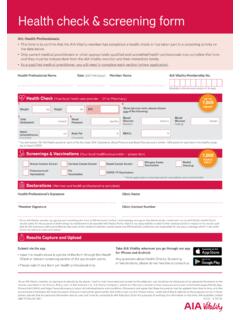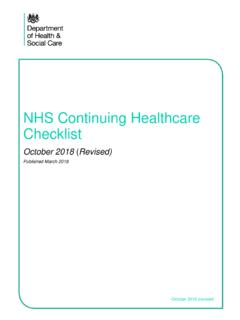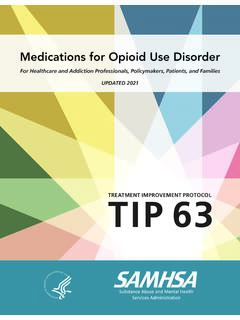Transcription of Screening for Adverse Childhood Experiences and Trauma
1 TECHNICAL ASSISTANCE tool | FEBRUARY 2019. Screening for Adverse Childhood Experiences and Trauma By Meryl Schulman and Alexandra Maul, * Center for Health Care Strategies IN BRIEF. As Trauma -informed care continues to gain traction, more and more providers are beginning to screen patients for exposure to Adverse Childhood Experiences (ACEs) and Trauma . However, variation exists regarding when and how to screen in both adult and pediatric populations. This technical assistance tool offers various approaches and considerations for Screening adults and children for ACEs and Trauma . It draws from the Experiences of pilot sites that participated in Advancing Trauma -Informed Care (ATC), a multi-site demonstration made possible by the Robert Wood Johnson Foundation that sought to identify how Trauma -informed approaches can be practically implemented within the health care sector.
2 M. any experts in the field agree that Screening for Adverse Childhood Experiences (ACEs) and Trauma is an integral component of a Trauma -informed approach to care. There are varying opinions, however, on when and how to screen in adults and children, and what to do with the information obtained from Screening . This technical assistance tool , made possible by the Robert Wood Johnson Foundation, outlines how organizations participating in the Advancing Trauma - Informed Care (ATC) initiative are Screening for Childhood and adult ACEs and Trauma . Drawing on the Experiences of the ATC sites, this tool offers key considerations for health systems and provider practices looking to integrate Screening for ACEs and Trauma into their clinical workflow, including when and how to screen, and the importance of identifying appropriate referral pathways.
3 Considerations for Screening for ACEs and Trauma There are a variety of considerations that providers should acknowledge prior to Screening for ACEs and Trauma . While best practices related to Screening for ACEs and Trauma are still evolving, many providers agree on the following: 1. Treatment setting and patient population should guide Screening . Upfront, universal Screening may be more appropriate in primary care settings, particularly among those working with pediatric populations. Other providers, such as behavioral health clinicians, may prefer to screen for Trauma after a patient and provider have an established relationship. Variation in the frequency and type of Screening tool used might also exist between treatment settings, and between those working with adult and pediatric populations.
4 Made possible through support from the Robert Wood Johnson Foundation. The views expressed here do not necessarily reflect the views of the Foundation. *Alex Maul is a former senior program officer at the Center for Health Care Strategies. For the purposes of this TA tool , the terms Screening and assessment tool are used interchangeably. The Center for Health Care Strategies does not endorse any specific tool to screen or assess for Adverse Childhood Experiences , Trauma , or toxic stress. TECHNICAL ASSISTANCE tool | Screening for Adverse Childhood Experiences and Trauma 2. Screening should benefit the patient. Providers Screening for Trauma must have a clear strategy in place for utilizing the information in a way that supports patients' health, including an established referral network.
5 3. Care coordination should be employed to avoid rescreening. Sharing results across treatment settings with appropriate privacy protections may help reduce rescreening and the potential for re-traumatization. However, in pediatric populations, Screening for exposure to ACEs is often conducted periodically since exposure may occur after initial Screening and throughout Childhood and adolescence. 4. Ample training should precede Screening . Health care professionals should be proficient in Trauma Screening and conducting patient follow-up in a manner that is sensitive to cultural and ethnic characteristics. When to Screen Providers and other health care professionals have differing opinions regarding when to screen for ACEs and Trauma .
6 Some providers believe that patients should be screened upon intake, when the patient-provider relationship is first developing. Proponents of this approach argue that upfront Screening provides a more complete understanding of a patient's history, helps guide interventions, identifies potential risk for chronic disease later in life, and is helpful for educating patients and caregivers on the long-term impacts of Trauma . Others, however, believe that Screening should not occur until after a trusting relationship is established due to the sensitive nature of the information being requested. Those who favor later Screening assert that Screening upon intake before relationships are established may hinder patients' decisions to share their history of adversity and Trauma , may re-traumatize a patient, and negatively impact the patient if no appropriate interventions are undertaken.
7 Regardless of the approach a provider takes, there is consensus that in general it is important to avoid rescreening whenever possible. How to Screen A number of considerations exist around how to screen patients in a Trauma -informed way, including: (1) which Screening and/or assessment tool should be used; (2) who should administer the tool , and how; and (3) which patients should be screened. Selecting the Right tool A variety of Screening and assessments tools exist, such as the original ACE questionnaire (see Exhibit 1, next page) and the Center for Youth Wellness' Adverse Child Experiences Questionnaire (CYW ACE-Q). 1 Health care practices are encouraged to adopt tools based on the needs of their patient population and clinical workflow.
8 As referenced in the Appendix, many providers have also adapted Screening and assessment tools, and other providers are exploring integrating ACEs questionnaires with other relevant assessments ( , social determinants of health). Administering the Screen Screening tools can be administered in a variety of ways. Some providers opt for face-to-face Screening in which a staff member ( , social worker, physician, or community health worker) asks the patient each question on the tool . Others have patients complete the tool independently ( , in a waiting or private room), as they may feel more comfortable disclosing information than discussing it verbally with a clinician. 2. TECHNICAL ASSISTANCE tool | Screening for Adverse Childhood Experiences and Trauma Another important consideration when Screening for exposure to adversity and Trauma is determining whether or not patients should be asked to disclose exposure to specific Experiences ( , physical abuse).
9 Some providers feel that treatment can be better tailored to the individuals'. needs when the specific adversities or traumas are disclosed, while others simply ask patients to provide the total number of categories of adversity experienced in order to triage appropriately. Exhibit 1. Finding Your ACE Score The ACE questionnaire is a simple scoring system that attributes one point for each category of Adverse Childhood experience. The 10 questions below each cover a different domain of Trauma , and refer to Experiences that occurred prior to the age of 18. Higher scores indicate increased exposure to Trauma , which have been associated with a greater risk of negative While you were growing up, during your first 18 years of life: 1.
10 Did a parent or other adult in the household often or very often Swear at you, insult YES NO If yes, enter 1 _____. you, put you down, or humiliate you? or Act in a way that made you afraid that you might be physically hurt? 2. Did a parent or other adult in the household often or very often Push, grab, slap, or YES NO If yes, enter 1 _____. throw something at you? or Ever hit you so hard that you had marks or were injured? 3. Did an adult or person at least five years older than you ever Touch or fondle you or YES NO If yes, enter 1 _____. have you touch their body in a sexual way? or Attempt or actually have oral, anal, or vaginal intercourse with you? 4. Did you often or very often feel that No one in your family loved you or thought you YES NO If yes, enter 1 _____.







